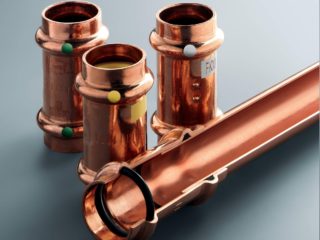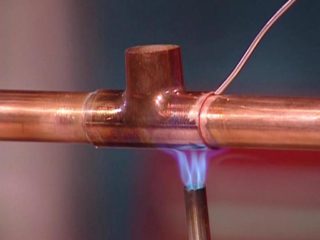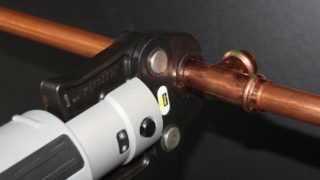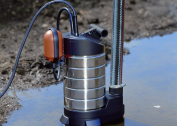In addition to steel, cast iron and plastic pipes, copper is used in water supply systems. This metal has several distinct advantages, but differs in cost. It is possible to make water supply from copper pipes, as well as install taps and other fittings from copper, in the absence of restrictions on the budget for repairs.
Metal specifications
Copper is the very first metal that the ancient people mastered. They made dishes and weapons from it. It is a soft material in its consistency, has antibacterial properties, so drinking water from copper utensils is considered safe. In contact with copper, viruses, bacteria and fungi die. It is useful to wear a copper bracelet to stimulate the thyroid gland. According to the Ayurveda recipe, it is recommended to leave water overnight in a copper vessel, and drink in the morning.
In plumbing systems, copper compares favorably with its competitors - steel and plastic. It withstands thermal fluctuations up to 250 degrees, does not change the characteristics during freezing - in the cold it becomes plastic and durable.
When installing a plastic pipe, you need to know exactly what pressure in the system they are designed for. If the plastic can withstand about 100 bar, then the copper pipe is 500 bar. This makes it possible to install additional equipment, for example, pumps to increase pressure in two- and three-story private houses.
Most often, copper pipes are produced with an admixture of zinc. The copper-zinc alloy is called brass. In addition to zinc, there are 5 more elements in it. According to GOST it is allowed to produce pipes for water supply from pure copper and from brass.
Due to impurities, the products last longer than plastic ones - up to 80 years, additives can inhibit corrosion processes, affect strength. If a crack occurs in a copper pipe, it does not extend over its entire length, so leaks are easier and faster to repair.
The weight of copper is 8920 kg / m3, which makes it the heaviest metal. For comparison, steel weighs 7800 kg / m3, polymers 900 kg / m3.
From copper, you can create the thinnest pipes with a minimum difference between the outer and inner walls. There are two types of copper pipe production:
- with annealing;
- without annealing.
The result is hard, semi-rigid and soft metal varieties. The installation of copper pipes for water supply also depends on how the product was manufactured.
Pipes are produced by rolling and pressing. The rolling method involves expanding the liner with a cold seamless method. Pressing is the welding of a copper sheet in an inert gas medium with subsequent calibration.
Types of copper pipes
In the assortment of copper pipes there are about 130 types of items that differ in shape, method of production, inner and outer diameter. Dimensions are in inches and millimeters.
Dimensions depend on the manufacturing method. Round products have a diameter of 3 to 350 mm. Wall thickness can vary from 0.8 to 10 mm.
Welded products have smaller sizes - from 30 to 280 mm. The wall thickness in welded and rectangular pipes can be more - from 5 to 30 mm.
Copper segments with a diameter of up to 18 mm and a length of up to 10 m are on sale. A larger diameter is sold in segments from 1.5 to 6 m.
Dimensions of imported products may vary. The above dimensions are inherent in domestic products.
Advantages and disadvantages of copper water supply
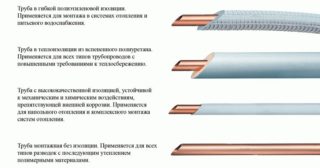 The advantages of copper plumbing include:
The advantages of copper plumbing include:
- Universality of connections.You can save on fittings and couplings, since welding provides a reliable connection - during pressure testing, the pipe body could not almost withstand the pipe, but the joints remained intact.
- The copper pipe does not deteriorate at low temperatures. The consequences of heating copper pipes are much less catastrophic than in the presence of steel or plastic water supply.
- Copper is not destroyed by chlorine, which is always present in tap water. On the contrary, a protective layer forms on the inner wall due to chlorine, which extends the life of the products.
- Under the influence of ultraviolet radiation, no visible changes occur on the surface of copper, unlike plastic, which must be insulated.
- Colonies of microorganisms and pathogenic bacteria do not take root on the inner walls.
- The roughness of the inner surface of copper pipes is lower than that of steel or plastic products, so organic substances do not have time to settle - the lumen does not narrow for a long time.
- You can buy copper products from any manufacturer - the quality will be the same. For example, among plastic products there are many fakes, which as a result have to be changed after a couple of years.
- Copper pipes have higher corrosion resistance, so there is less material to manufacture. Steel structures are forced to provide greater wall thickness with the expectation that rust will gradually destroy the material.
- In copper lines there is no need to service joints, since they are more reliable than the pipes themselves. In non-welded steel structures, fittings are a major problem.
The disadvantages of copper water supply:
- The cost is higher.
- Cannot be installed in systems where the water flow rate is higher than 2 m / s.
- There should be no sand and other solid particles in the water, since they erase the inner layer of the wall. If it is too thin, it can cause erosion.
- More installation requirements, so as not to reduce the warranty period.
Lead should not be used as solder in drinking water systems, since it causes poisoning of the body and serious consequences.
The pros and cons of a copper water supply system also depend on how well the installation is done.
Installation and connection methods
The most common method is soldering. For this, it is necessary to heat the pipe to the melting point of the solder. Solder copper pipes for water supply can only experienced welders, who often work with pressure systems and with complex communications in private and multi-apartment buildings.
The process is carried out as follows:
- The junction of the pipe and fitting is cleaned of oxide film.
- The gas burner heats the solder and gradually wraps around the product as it melts.
- In order for the solder to flow between the pipe and the fitting, the place is warmed up for a few more seconds.
Systems connected by welding can withstand pressures of up to 500 bar, with proper operation, leakages and depressurization of the line are excluded.
The pressing method is not very tight and reliable, it is better to use it in systems with low pressure. The bottom line is to assemble the system, and then with a special tool, press the fitting to the main pipe. Can be clamped with a sealing belt and nut. For control, it is necessary to make marks on the parts so that they do not budge when crimped. It is important to sand the ends of the pipes well before connecting to the fittings.
The advantage of the pressing method is that even a beginner can put it into practice. The solder welding method is a much more complex operation requiring skill and an eye.
